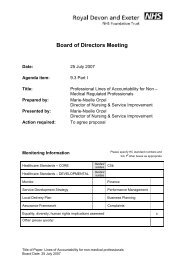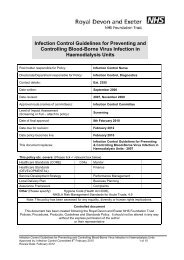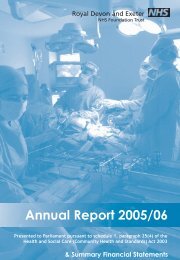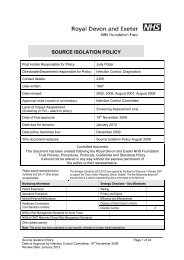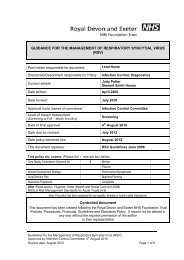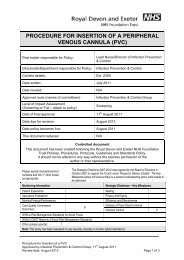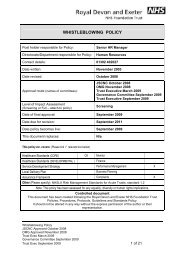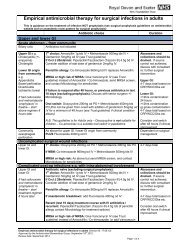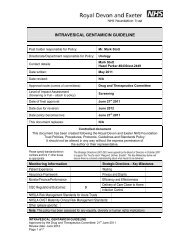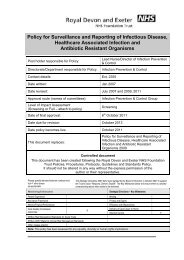Annual Report and Accounts 2012/13 - Royal Devon & Exeter Hospital
Annual Report and Accounts 2012/13 - Royal Devon & Exeter Hospital
Annual Report and Accounts 2012/13 - Royal Devon & Exeter Hospital
Create successful ePaper yourself
Turn your PDF publications into a flip-book with our unique Google optimized e-Paper software.
94 4. Our Governance<br />
<strong>Royal</strong> <strong>Devon</strong> <strong>and</strong> <strong>Exeter</strong> NHS Foundation Trust<br />
<strong>Annual</strong> <strong>Report</strong> <strong>and</strong> <strong>Accounts</strong> <strong>2012</strong>/<strong>13</strong><br />
• The Trust’s self assessment process<br />
for assessing compliance with Care<br />
Quality Commission Regulations for<br />
the period April <strong>2012</strong> to March 20<strong>13</strong>.<br />
4.4 The Governance Committee is<br />
chaired by a Non-Executive Director<br />
<strong>and</strong> provides leadership to the<br />
risk management process. The<br />
Committee takes a comprehensive<br />
oversight of the quality <strong>and</strong> safety<br />
of care provided by the Trust <strong>and</strong><br />
provides assurance to the Board<br />
of Directors. The work of the<br />
Governance Committee is supported<br />
by five key sub-committees:<br />
• Integrated Safeguarding<br />
Committee<br />
• Clinical Effectiveness Committee<br />
• Workforce <strong>and</strong> Diversity<br />
Committee<br />
• Safety <strong>and</strong> Risk Committee<br />
• Engagement <strong>and</strong> Experience<br />
Committee.<br />
These five committees are<br />
responsible for monitoring <strong>and</strong><br />
managing specific types of risk.<br />
4.5 The Adverse Events Forum is<br />
chaired by a consultant clinical lead<br />
<strong>and</strong> reviews all adverse incidents,<br />
Clinical Audits <strong>and</strong> Mortality <strong>and</strong><br />
Morbidity Reviews. The Incident<br />
Review Group is chaired by the<br />
Deputy Chief Nurse <strong>and</strong> Patient<br />
Care <strong>and</strong> reviews all Serious<br />
Incidents Requiring Investigation<br />
(SIRI) <strong>and</strong> action plans.<br />
<br />
Other specialist Groups led by a<br />
Director or senior clinician include:<br />
• Clinical Audit <strong>and</strong> Guidelines<br />
Group<br />
• Medical Devices Group<br />
• Medicines Management Group<br />
• Medical Gases Group<br />
• Patient Safety Programme Group<br />
• Radiation Safety Group<br />
• Trust Infection Control <strong>and</strong><br />
Decontamination Assurance Group<br />
• Drugs <strong>and</strong> Therapeutics<br />
Committee.<br />
5. Risk Identification<br />
<strong>and</strong> evaluation<br />
5.1 The Trust has a risk management<br />
strategy which has been approved<br />
by the Board of Directors <strong>and</strong> clearly<br />
sets out the process for identifying<br />
<strong>and</strong> managing risk. It incorporates<br />
a st<strong>and</strong>ard methodology in which<br />
risk is evaluated using a likelihoodconsequence<br />
matrix. The roles<br />
<strong>and</strong> responsibilities of staff in<br />
managing risk are defined <strong>and</strong> key<br />
posts highlighted. The strategy also<br />
includes the governance reporting<br />
structure <strong>and</strong> the terms of reference<br />
of the Governance Committee <strong>and</strong><br />
all the committees reporting to the<br />
Audit Committee <strong>and</strong> Governance<br />
Committee.<br />
5.2 The Board has developed a revised<br />
Board Assurance Framework; it<br />
focuses on risks, controls <strong>and</strong><br />
plans to address gaps in control<br />
that might impact on the delivery<br />
of the Trust's strategic objectives.<br />
The highest strategic risk identified<br />
is the failure to deliver the<br />
recurrent annual £17 million Cost<br />
Improvement Programme (CIP).<br />
Controls <strong>and</strong> plans are in place but<br />
the risk is not fully mitigated.<br />
5.3 The Trust maintains a<br />
comprehensive Corporate Risk<br />
Register covering both clinical <strong>and</strong><br />
organisational risk. There are 33<br />
current risks on the Corporate Risk<br />
Register. All identified risks have<br />
clear mitigation plans in place. Of<br />
the Trust’s eight highest scoring<br />
risks, four relate to a diagnostic test<br />
ordering <strong>and</strong> result communication<br />
system, one relates to storage of<br />
medical records, one relates to<br />
administrative staffing within one<br />
area of the Trust, one relates to the<br />
installation of a tracking system<br />
for medical equipment <strong>and</strong> one<br />
relates to the care of an individual<br />
patient. These risks are assigned<br />
to an appropriate executive lead<br />
<strong>and</strong> manager who are responsible<br />
for ensuring that the risk is<br />
either eliminated or managed<br />
appropriately. A robust system is in<br />
place to monitor progress of action<br />
plans. This is undertaken by both<br />
the Head of Governance <strong>and</strong> the<br />
Divisional Governance Groups to<br />
ensure that risks are proactively<br />
managed down to their end target<br />
score. A detailed report is produced<br />
by the Head of Governance to the<br />
Safety <strong>and</strong> Risk <strong>and</strong> Governance<br />
Committee each time they meet.<br />
5.4 The Trust has Directorate-level<br />
risk registers which feed into<br />
the Corporate Risk Register. At<br />
Directorate level, the risk registers<br />
contain lower-level localised risks,<br />
which can be managed by the<br />
relevant Directorate. The Corporate



